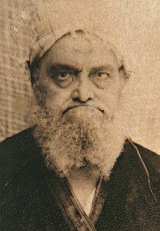
Back محمد زكريا الكاندهلوي Arabic محمد زكريا الكاندهلوى ARZ জাকারিয়া কান্ধলভি Bengali/Bangla Muhammad Zakarīyā al-Kāndahlawī German મુહમ્મદ ઝકરિયા કાંધલવી Gujarati मुहम्मद ज़करिया कांधलवी Hindi Muhammad Zakariya al-Kandhlawi ID Мұхаммед Закария әл-Кандеһләуи Kazakh محمد زکریا کاندھلوی PNB محمد زکريا کاندهلوي Pashto/Pushto
Zakariyya Kandhlawi | |
|---|---|
زکریا کاندھلوی | |
 | |
| Personal details | |
| Born | 3 February 1898 Kandhla, North-Western Provinces, British India |
| Died | 24 May 1982 (aged 84) Medina, Saudi Arabia |
| Resting place | Al-Baqi Cemetery |
| Alma mater | Mazahir Uloom |
| Personal life | |
| Children | Muhammad Talha Kandhlawi (son) |
| Main interest(s) | |
| Notable work(s) | |
| Religious life | |
| Denomination | Sunni |
| Jurisprudence | Hanafi |
| Movement | Deobandi |
| Senior posting | |
| Disciple of | Khalil Ahmad Saharanpuri |
Influenced by | |
Influenced | |
Zakariyya Kandhlawi (Urdu: زکریا کاندھلوی; 3 February 1898 – 24 May 1982) was a mid-twentieth-century traditionalist Sunni scholar and an authority in the study of hadith, also known as Sheikh al-Hadith, hailing from India. He was an influential member and ideologist of Tablighi Jamaat and the author of the Fada'il series, which is a crucial propagation literature for the movement.[1] Born into a family deeply rooted in Tablighi Jamaat and associated with the Deobandi movement, he studied under Mazahir Uloom and eventually became a teacher there in 1917, retiring over half a century later in 1968.[2] Engaging with Sufism, a distinctive feature of the mainstream Indian Ulama, he was a student of Khalil Ahmad Saharanpuri in both hadith and spirituality.[2] Together, they embarked on a ten-year journey to compile Badhl al-Majhud, an explanatory work on Sunan Abu Dawood. Initially published in five volumes, he expanded it to a twenty-volume collection. He made his first trip to Medina with Saharanpuri at a young age, and in 1972, he settled in Medina and continued his missionary work from there until his death. He was buried next to his teacher Saharanpuri at Al-Baqi Cemetery, whose successor he had been named.[3] During his initial stay in Medina, he began working on a commentary on Muwatta Imam Malik, eventually publishing Awjaz al-Masalik over a thirty-year period. This work quickly earned him a reputation for his expertise in interpreting the Maliki tradition.[2] The first edition, published in six volumes in India, was followed by a fifteen-volume second edition, with the first three volumes printed in Cairo and the remaining volumes in Beirut.
He wrote extensively in both Arabic and Urdu, without any copyright restrictions on his publications, covering diverse subjects such as hadith, Fiqh, Tafsir, Tajwid, historical and biographical topics, ethical practices, moral principles, as well as contemporary groups and movements.[2] Additionally, he worked on his father's collection of hadith lectures by Rashid Ahmad Gangohi. From 1932 to 1934, he focused on lectures related to Sahih al-Tirmidhi and published his work, Al-Kawakib al-Durri, which included his own annotations and marginalia. Between 1956 and 1968, he dedicated his efforts to publishing Gangohi's lectures on Sahih al-Bukhari, known as Lami al-Darari. Another contribution was his authored work, Al-Abwab wa al-Tarajim, aimed at establishing the relationship between chapter headings and the hadiths in Sahih al-Bukhari, providing 70 principles for interpreting the subject matter. He shared glimpses of his life and scholarly journey through his autobiography, named Aap Beati, which spanned seven volumes.
- ^ Gaborieau, M. (2012). Zakariyyā Kāndhalawī Sahāranpūrī. Encyclopaedia of Islam, Second Edition. Brill. doi:10.1163/1573-3912_islam_sim_8095. ISBN 9789004161214. Archived from the original on 15 January 2022. Retrieved 13 June 2023.
- ^ a b c d Metcalf, Barbara D. (2009). Zakariyya, Maulānā Muḥammad. The Oxford Encyclopedia of the Islamic World. Oxford University Press. ISBN 978-0-19-530513-5. Archived from the original on 2 July 2023. Retrieved 26 June 2023.
- ^ Özşenel, Mehmet (1988–2016). "KANDEHLEVÎ, Muhammed Zekeriyyâ". TDV Encyclopedia of Islam (44+2 vols.) (in Turkish). Istanbul: Turkiye Diyanet Foundation, Centre for Islamic Studies.